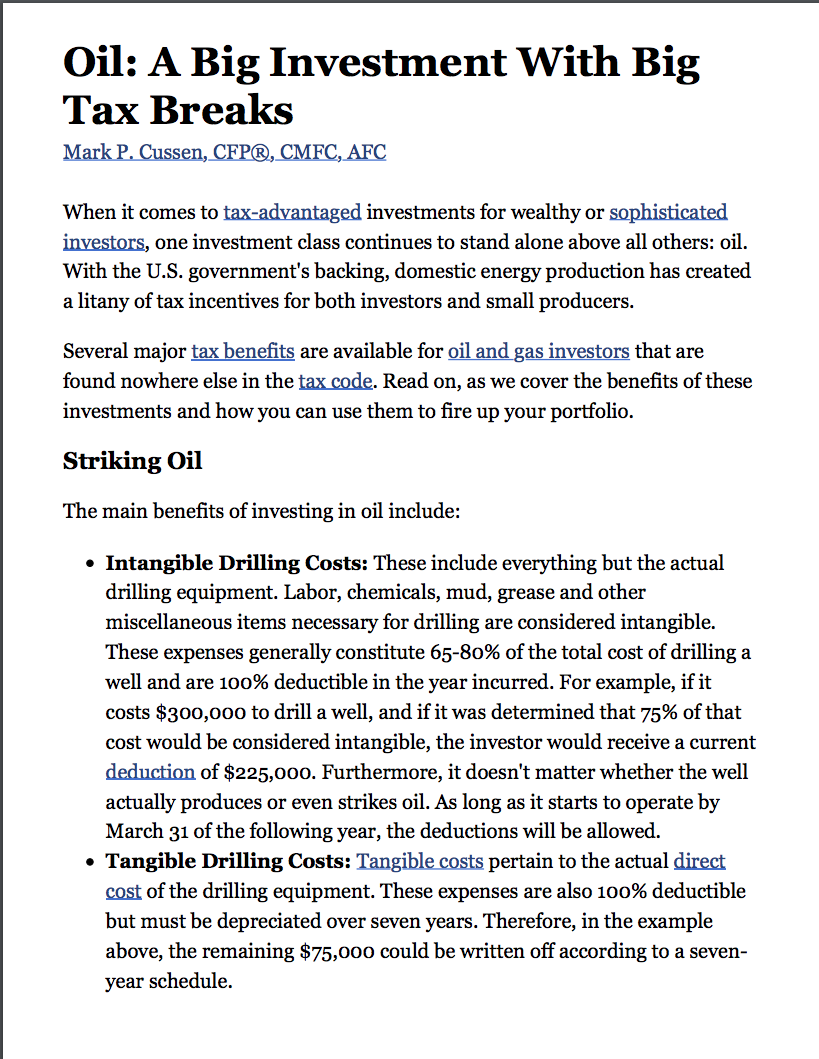
What are the Tax Benefits?
Tax Considerations of investing in Oil and Gas Working Interest Drilling Programs:
Oil and Gas Investments offer substantial Tax Deductions. Although it is everyone’s civic duty to pay income tax to help fund our government, the government provides tax deductions for situations that contribute overall to the country’s wellbeing. You may have heard oil and gas working interest drilling programs can help reduce your tax bill. It is true, so let’s look into this further.
What you will learn here is an introduction into the tax benefits oil and gas working interest drilling programs provide. After reading it, you should have a basic understanding of these deductions that can reduce your tax bill. We are among the first to agree that tax forms and instructions require a bit of study to get the numbers right. So at tax time, you might need to contact an accountant for additional information. But for now, please read further…
The U.S. government would like our country to become less dependent on foreign resources. So in order to encourage domestic oil and gas production, direct investments in oil and gas offer larger tax breaks than any other type of investment.
Ranken Energy Working Interest Program Considerations
Ranken Energy Working Interest Drilling programs today certainly have a good probability of striking oil and/or gas, which means you the investor earn income. And your income is partially sheltered from taxes because of a depletion allowance. Here is why:
- Depletion allowance: Because oil and gas are finite resources that will eventually be exhausted, depletion allowances are granted for a portion of the producing well’s gross income. These allowances can shelter 15% of the annual production from income tax. Deductions can be taken as long as the wells are productive.
- Tangible Costs represent substantial expenses like storage tanks, pump jacks, and casing. Tangible costs are capitalized and depreciated over seven years.
- Intangible Drilling Costs (
IDCs ) are expenditures that have no salvage value – this would be fuel, wages, hauling, contracted drilling and repairs. They typically comprise 75% to 85% of the total well cost and are 100% deductible against taxable income in the first year. - Intangible Completion Costs (
ICCs ) average around 15% of the total cost of the well. ICCs are goods and services like labor, completion materials, completion rig time and fluids that have no salvage value. ICCs are completely deductible in the year the expense was incurred. - Depreciation: The tangible equipment and resources used to complete a well are generally considered salvageable, and thereby are depreciated over a 7-year period. These tangible completion expenses can account for between 25% and 40% of the total well costs.
- Lease operating expenses are the ongoing monthly costs to operate the
well, and are deductible in the year the expenses are incurred. - Amortization of Geology and Geophysical costs
IRS tax code Section 167(h) Amortization of Geological and Geophysical Expenditures
You can deduct these costs at 25% the first year, 50% the second year and 25% the third!
- 167. Depreciation
- h) Amortization of geological and geophysical expenditures
(1) In general
Any geological and geophysical expenses paid or incurred in connection with the exploration for, or development of, oil or gas within the United States (as defined in section 638) shall be allowed as a deduction
(2) Half-year convention
For purposes of paragraph (1), any payment paid or incurred during the taxable year shall be treated as paid or incurred on the mid-point of such taxable year.
(3) Exclusive method
Except as provided in this subsection, no depreciation or amortization deduction shall be allowed with respect to such payments.
More about Taxes of investing in Working Interest Drilling programs
* Unique to Oklahoma, Severance Taxes in Oklahoma have recently been reduced from 7.1% to 2%.
The complex and difficult to manage Severance Tax legislation was replaced by a 2% tax levied for the first 36 months of production on newly drilled wells. After 36 months the tax rate returns to 7.1%. This grants those who own the well 5% additional revenue for the first 3 years of the well’s life, which often will
*1031 Exchange Compatible. Section 31 of the IRS Tax Code allows a seller of real estate defer capital gains taxes if they reinvest in a Working Interest Drilling program.
*Suitable for IRA’s. The IRS Tax Code allows investors to put Working Interest Drilling Program investments in IRA’s. This lets you shelter monthly cash flow from taxes, allowing you to reinvest more of what you have earned. However, typical banks or brokerage companies do not handle this type of IRA. Ask your accountant to recommend those with whom he is familiar that do.
In the end, oil and gas investments offer substantial Tax Deductions but you may need professional guidance to take full advantage of the tax laws.
If you invest in oil and gas well drilling activities, you will receive at tax time appropriate statements from Ranken Energy Corporation tabulating the above costs so you can take these deductions when you file your taxes. And like we stated above, your accountant can go over more details then.
So there you have it: an introduction to the tax benefits available when investing in oil and gas working interest drilling programs. The Internet contains many related articles, but it is unlikely you will find any entertaining videos on tax benefits!
Here is an excellent article from Investopedia that discusses several advantages.
Have questions or comments? We want to hear from you.
Learn more about Ranken Energy


